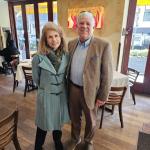We shall not cease from exploration
And the end of all our exploring
Will be to arrive where we started
In “The Wisdom of Stability”, the author draws on both his own experience, and the testimony of church history to declare that there’s wisdom in declaring our default position to be that we’ll remain right where we are, putting down roots and going deeper rather than embracing the mobility lifestyle that so characterizes our time and culture.
I think of the poetry at the top of this post in this light because the Hartgrove’s declaration is that our movement is, all too often, rooted in the belief that a change of circumstances is just what we need, ‘just what the doctor ordered’ in order to cure the bitterness or shame, cynicism or boredom, which ails us.
Yes, that’s it. We’ll just change neighborhoods, or churches, or careers, or spouses – that’ll fix everything. The problem is that it just doesn’t work that way. We travel the globe whether out of zeal for Christ, or personal ambition for wealth or experiences, only to find that there are things that we need to put behind us which we’ll never escape until, ironically, we learn to stay where we are – things like fear of truth telling, or our instinct to disengage when we become disillusioned. So we travel far away, only to find that we’re right back where we stared, even if we’ve moved 6,000 miles from home.
Hartgrove writes of his early years, globtrotting for Jesus but writes that, in spite of “racking up all those frequent flyer miles for Jesus” he felt lonely. Eventually (it’s a compelling story, even in the introduction), he and his wife settled in Durham, North Carolina, founding a community called “Rutba House” there. Much of what he writes comes out of his first hand experience, as he juxtaposes the life of rootedness and continuity with the prevailing mobility and distraction. He writes that “teachers ancient and contemporary challenged us to stay put”, and the book includes his lessons learned along the way.
This would be valuable enough, but the author goes further by drawing on the teachings of both the Desert Fathers, and the Benedictines, with their common life of daily pray. His call to a gentle rhythm of familiarity and continuity, of daily prayer and bible reading, weaves threads between the horizontal relationships of our lives and the vertical relationship of intimacy with God. Rightly, we’re challenged to exorcise any notions that we can ever have either one without the other.
When I arrived at Bethany Community Church in Seattle, I was more than a little anxious over the five year commitment asked of me by the leaders before they’d offer me the job as pastor. That was fifteen years ago, back in my hyper-mobility days. I’m profoundly grateful to belong to a community that’s grace filled enough to have forgiven me over and over again as their very human shepherd. They’ve taught me the glories of continuity, especially those ones who’ve been there for so many years that I’ve not only done their weddings, but are now watching their children enter middle-school! Wow!
Many things have contributed to the grace of practicing a little continuity, but event stands out above all others. Shortly after arriving, we’d been invited for supper over the house of some folks who were then new to us, but have now become very dear friends. I’d been a Christian for a long time when I walked in that house that night, but my adult life had been relatively rootless. Two years here. Three years there. Six years There. Six more there. Along the way, I’d become a Bible teacher who’d fly in for a week and speak at conferences or a bible college, and then leave. I enjoyed it – still do. But that night, I realized that I was in the midst of something different.
As the candles burned low and we lingered at the table, I realized that these people knew each other deeply, loved each other well, authentically. Their intimacy was tested, and the miles of their lives had been racked up, not on airplanes so much, but in the presence of each other. In a moment when there was some silence, I filled the void with this: “Wow. I’d like to belong to a small group like this one.”
I’ll never forget what came next. Someone said, “Stick around for twenty years and that might happen.”
She was right, and the seeds of continuity planted then have recently begun to bear a kind of fruit I didn’t even know existed back when “mobility” and “keep your options open” were the mantras that tossed me around.
Hartgrove exposes the rich foundation for the truths that some of us have learned through experience and others have yet to experience. That, it seems, means that it’s a good read for all of us.















